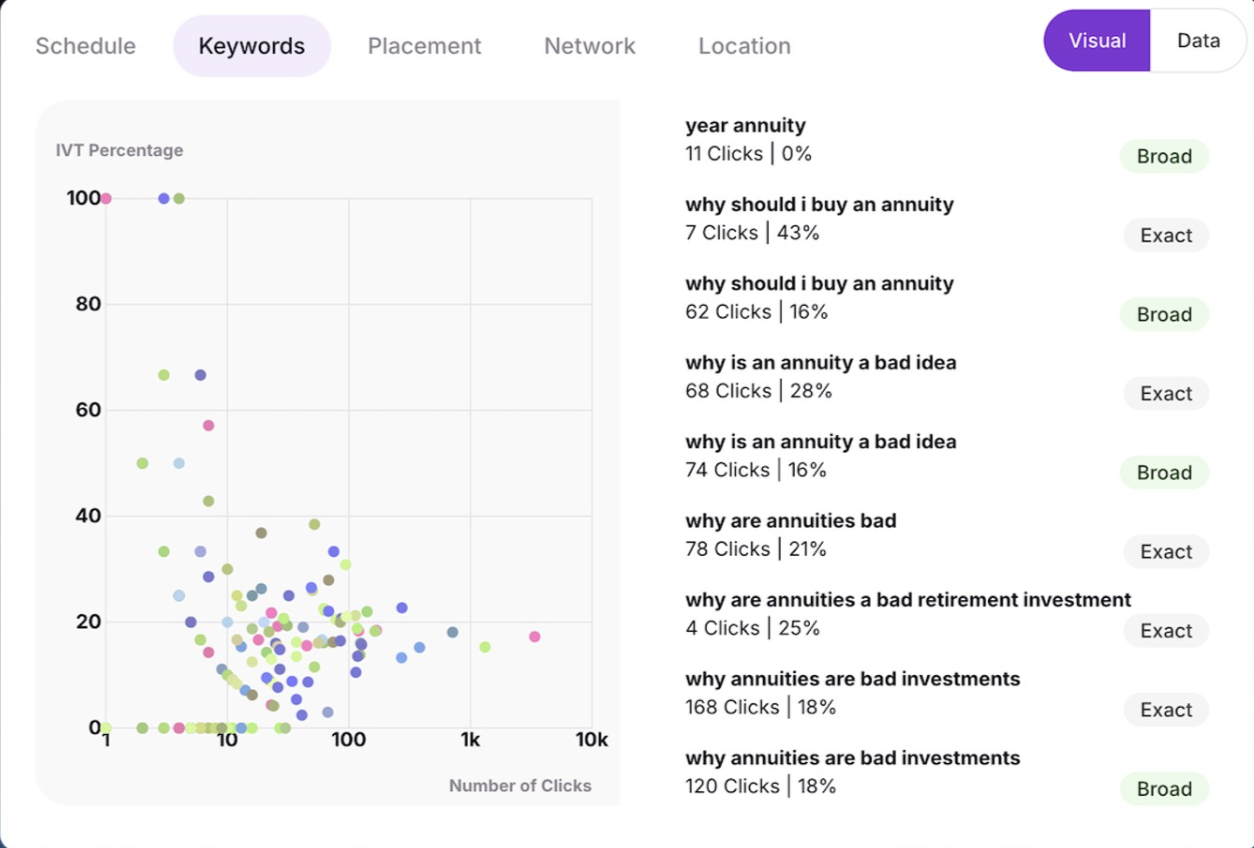Ever come across a website so stacked full of ads it’s harder not to click one? If so, it’s likely you’ve encountered made-for-advertising websites.
Made-for-advertising (MFA) websites are designed to prioritize ad revenue over everything else, including user experience, content value, and genuine conversions. And while they’re pretty easy for the human eye to spot, they’re really good at digital disguise — which means the algorithms that decide where to serve your ads often see them as lucrative placements.
In Q4 2024, 11% of ad spend worldwide went to MFA sites. That’s more than a dollar in every $10 being wasted on dodgy sites — a dollar that won’t go towards generating actual revenue for your brand.
Spotting and excluding MFA sites from your ad placements isn’t easy. Many marketers don’t realise their ads are appearing on made-for-advertising sites. But if you know what to look for, you can prevent these spammy ad placements and redirect your ad budget to quality sites and placements.
Here, discover all you need to know about made-for-advertising sites: what they are, how to identify them, why they’re a threat to performance marketers, and what you can do to stop your ads appearing on MFA sites.
What are MFA sites?
Made-for-advertising sites are websites that run for the exclusive purpose of generating ad revenue for the site operator. But unfortunately, this doesn’t usually translate to revenue for the brands and businesses whose ads are shown on MFA sites.
Hallmarks of MFA sites include:
- Low-quality content — Think thin or recycled content, especially with clickbaity headlines.
- Display ad overload — Banner ads are plastered across the site, creating high ad-to-content ratios.
- High bounce rates — MFA sites skimp on user experience, so most users click away from them pretty quickly.
- Part of ad arbitrage schemes — They use shady practices like buying bot traffic to artificially increase site traffic volume.
- Rapid ad refresh rates — Ads refresh quickly to increase the number of ads shown to a single user.
MFA site examples
Made-for-advertising sites tend to include content that’s cheap and easy to accumulate. These include:
- Fake news blogs
- Recipe aggregators
- Listicle and slideshow sites
- Quiz and personality test sites
- Coupon sites and deal aggregators
A typical MFA site may look like this, with ads crammed into every corner of the page and minimal actual content:

How MFA sites threaten your ad performance
With the advent of AI, made-for-advertising sites are getting better at gaming the system. AI makes it quicker to generate basic clickbait content, goading users onto MFA sites where the proliferation of ads encourages clicks (actual or accidental). This maximizes their profits while reducing your campaign performance.
Here are the key ways MFA sites jeopardize your PPC performance:
- Fake traffic — Ads are shown to users who are never going to convert (some MFA sites generate or buy bot traffic to boost impressions).
- Skewed performance data — Advertisers may see artificially inflated impressions and clicks in their metrics, without any meaningful engagement.
- Distorted optimization — MFA sites can make themselves appear legitimate to algorithms, causing them to allocate spend to poor MFA placements.
- Sullied brand reputation — Appearing on sites with spammy, irrelevant, or inappropriate content may compromise your brand value.
Ultimately, MFA sites will drain your ad spend without generating meaningful conversions. They line their own pockets without creating revenue for advertisers themselves.
How MFA sites infiltrate your campaigns
While MFA sites are visibly easy to spot, it can be hard for algorithms to detect them. The table below outlines five main ways MFA sites infiltrate PPC campaigns.
| Approach |
How it works |
Why it works |
| Programmatic loopholes |
MFA sites exploit vague contextual targeting settings in open programmatic ad exchanges (such as “lifestyle” or “news” categories). |
Thousands of sites compete on large exchanges, so domain vetting is limited. MFA sites can pass the basic checks needed to access these exchanges. |
| Misleading placement names |
MFA sites use name spoofing or misleading naming conventions (for example, using “apnewss.com” instead of “apnews.com” to appear similar to a legit news site). |
It’s easy for MFA sites to fly under the radar of even savvy media buyers and algorithms when mimicking legitimate sites. |
| Platform filter exploitation |
MFA sites spring up under new domains regularly, so it’s hard for ad platforms to keep blacklists and filters current. |
As well as the reactive nature of filters, ad platforms have little incentive to aggressively police MFA sites. So filter effectiveness tends to be limited. |
| Cheap cost-per-milles (CPMs) |
MFA inventory is extremely cheap, with CPMs often a fraction of premium publishers. Advertisers aiming to boost reach often get more impressions from MFA sites. |
Inflated impressions can look good in marketing reports (even if performance is poor on closer inspection). |
| Automation |
Auto-generated content, AI-written articles, and scraped content help MFA sites appear legitimate to crawlers and bots. They scrape trending content from reputable sites, then reword or spin the text to avoid duplicate content penalties. |
MFA sites can outrank legitimate publishers in search for low-competition terms. So they may get traffic (and therefore ad revenue) that rightfully belongs with the original publisher. |
How to identify MFA traffic
When reviewing your performance marketing results, be vigilant for the following MFA traffic red flags:
- An unusually high click-through rate with low on-site engagement
- High bounce rates with low time on page
- Traffic from domains with long strings or random characters
Lunio’s advanced campaign analytics can help you detect and block low-value ad placements in real-time. It eliminates the need to manually review your results for MFA sites, which only allows you to identify them reactively (and takes ages).

With our advanced campaign analytics feature, you can pinpoint and exclude suspicious traffic sources automatically, protecting your ad budget and performance analytics from low-value MFA traffic.
Not yet using Lunio’s advanced automation? You can use the placement report in Google Ads (as well as Google Analytics and other reporting tools) to manually identify and filter out suspicious sites.
How to proactively stop MFA sites draining your budget
While blacklisting MFA sites from your ad campaigns can help, it doesn’t tackle the MFA problem at the source. To do this, take the following proactive steps to stop MFA sites wasting your ad budget.
1. Exclude low-quality placements
Excluding dodgy placements from your ad campaigns is an essential tactic for limiting MFA placements. As well as adding individual spam sites from placement reports, you can proactively exclude known MFA sites from your campaigns.
Download our free placement exclusion lists and exclude them from your Google Ads campaigns to quickly and effectively remove junk placements:
(Be aware of Google’s exclusion limits — regular users can add up to 20,000 placement exclusions at once, and up to 65,000 placement exclusions in total (per account). Managers can create up to three exclusion lists with up to 250,000 exclusions per list.)
2. Reallocate budgets to more effective marketplaces
Different ad exchanges tackle MFA sites with varying levels of success. If your ads are prone to junk MFA traffic, it may be time to redirect your budget away from your current ad exchange to more lucrative marketplaces. For example:
- Direct buys — Identify publishers with a highly relevant audience and negotiate a direct advertising relationship with them. This gives you more control over where and when your ads are shown, and puts your ads in front of a high-intent audience.
- Programmatic ad platforms — Experiment with other ad platforms if you’re unhappy with the placements you’re getting. Consider The Trade Desk, MediaMath, or StackAdapt.
- Curated marketplaces — Find premium ad space in curated advertising marketplaces, such as Outbrain or Taboola.
- Channel-specific platforms — Some marketplaces cater for specific channels, such as connected TVs and email advertising placements.
3. Tighten up your targeting
Improving your targeting settings can help programmatic ad exchanges direct your ads to better value placements. Instead of giving vague directions (such as selecting broad categories like “news”, “lifestyle”, or “food”), be super specific about where and when you want your ads to serve:
- Specific site lists — Whitelist trusted sites so ad exchanges can prioritize displaying your ads here.
- First party data — Use your customer/lead lists to create and target similar audiences.
- Behavioral targeting — Create targeting settings based on user activity, rather than vague contextual interests that can be misinterpreted.
How Lunio helps eliminate MFA traffic automatically
Lunio detects and removes invalid traffic from your ad campaigns, keeping them profitable. This extends to MFA traffic — with Lunio, you’ll get real-time protection from low-quality traffic from made-for-advertising sites, eliminating it before it reaches your analytics or eats up your budget.
Lunio goes beyond domain blacklists. Our automated software analyzes on-site behavior to identify low-quality traffic patterns. There’s no need to manually refine targeting or settings in response — it’s all taken care of automatically. And even better, MFA sources are auto-blocked from future targeting across all your ad platforms and channels.
Lunio is proven to help you minimize waste so you can focus your ad spend on genuine conversions. PPC agency Mabo saves £32,700 every month on average — money their clients can reinvest in profitable campaigns.
Plus, Lunio’s advanced campaign analytics give you a single source of truth that isn’t biased towards a specific ad platform, giving you the most accurate, reliable data.
Beat sophisticated MFA sites with Lunio
MFA sites are getting better at gaming the system. So advertisers must take proactive steps to protect their ad spend. With the right tools and proactive measures, you can minimize waste and refocus your ad spend on genuine prospects and customers.
To see how much MFA traffic is reaching your site, request a free traffic audit.



